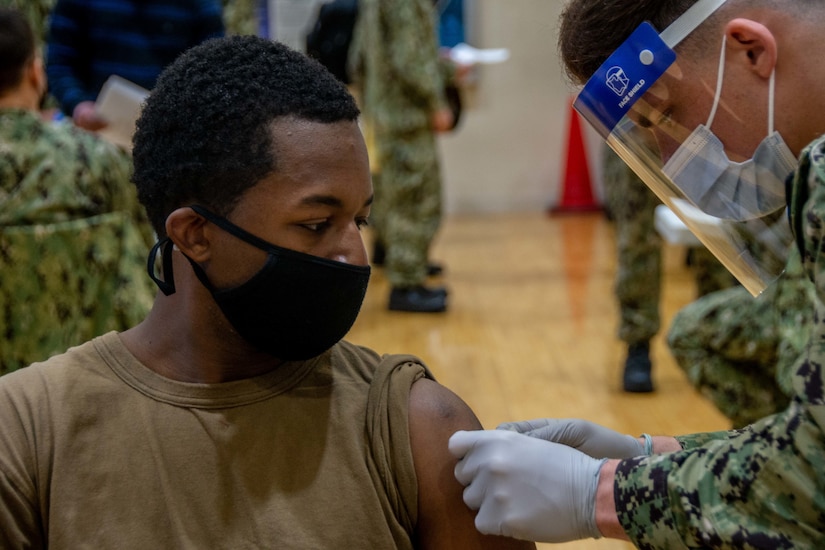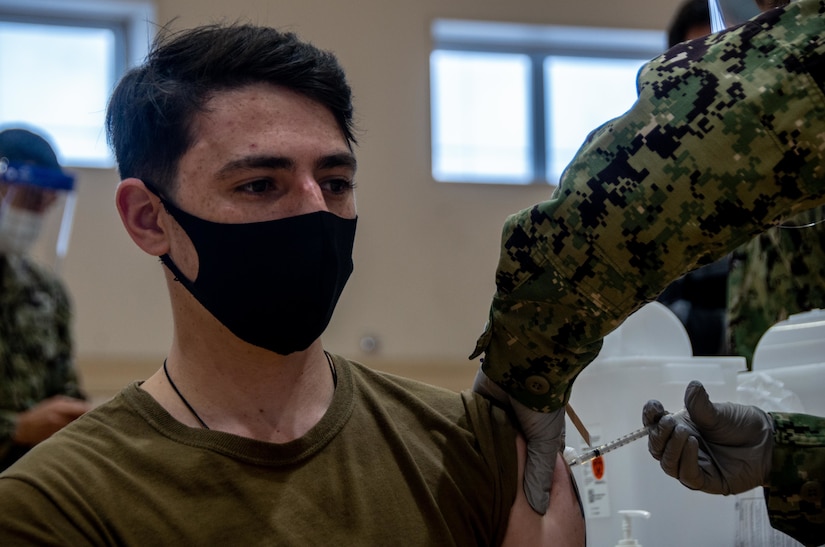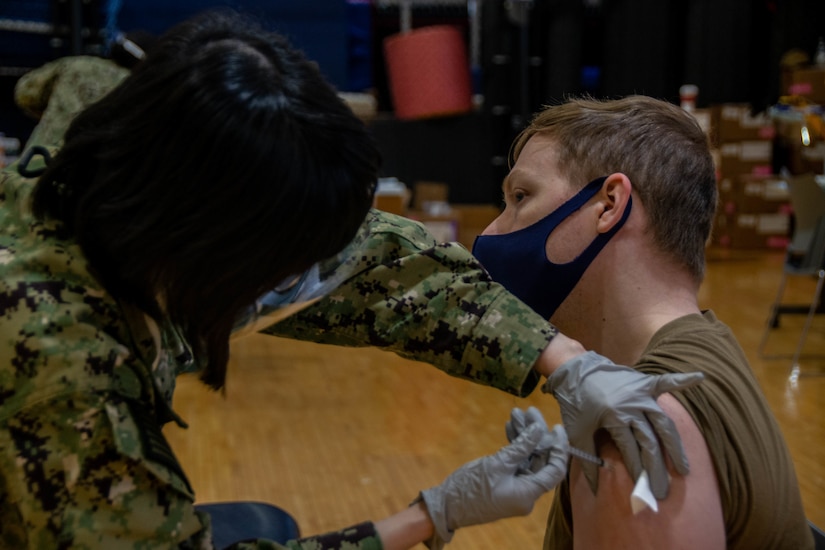Navy Petty Officer 2nd Class Dondre Summers performs maintenance on a close-in weapon system aboard the USS John S. McCain in the South China Sea, Feb. 6, 2021.
Providing up-to-date information, news and original content on American Military issues.
Navy Petty Officer 2nd Class Dondre Summers performs maintenance on a close-in weapon system aboard the USS John S. McCain in the South China Sea, Feb. 6, 2021.
Soldiers keep watch on targets during a joint combat live-fire event using the Gepard air defense system at Bemowo Piskie Training Area, Poland, Feb. 2, 2021.
American and French soldiers participate in a live-fire artillery training in Djibouti, Feb. 2, 2021.
Air Force KC-135 Stratotanker pilots look at the horizon over Tampa, Fla., Feb. 7, 2021. The aircraft performed a flyover with a B-2 Spirit and a B-1B Lancer during Super Bowl LV.
Navy Petty Officer 3rd Class Dominic Laforest administers the second dose of the Moderna COVID-19 vaccine to Navy Lt. Stephanie Harris, the preventive medicine department head at U.S. Naval Hospital Naples, onboard Naval Support Activity Naples, Italy, Feb. 5, 2021. USNH Naples began administering the COVID-19 vaccine on Jan. 8, 2021, and is now fully into Phase 2 of the DOD distribution schema, which includes eligible beneficiaries 18 years and older.
Navy intensive care unit nurses assigned to the Naval Medical Center in San Diego, Calif., shadow their assigned nurse manager, Elisha Riggins, at Hendrick Medical Center in Abilene, Texas, Jan. 29, 2021. The Navy medical personnel received orientation on their assigned floor and were introduced to their civilian counterparts during shadowing. Northern Command, through Army North, remains committed to providing flexible Defense Department support to the whole-of-government COVID-19 response.
Navy Seaman Michael Borgonia, assigned to Navy Medicine Readiness and Training Command San Diego, left, receives on-the-job training from another sailor, Sky Szegda, right, on how to properly administer a COVID-19 vaccine at Naval Medical Center San Diego, Feb. 5, 2021. Staff are making sure they are ready to deploy in support of future Defense Support of Civil Authorities missions and the federal COVID-19 response.
Air Force Staff Sgt. Dustin Reed guides military working dog Jenny during explosive detection training at Incirlik Air Base, Turkey, Feb. 2, 2021.
Air Force Global Strike Command bombers perform the Super Bowl LV flyover at Raymond James Stadium in Tampa, Fla., Feb. 7, 2021. The trifecta was the first of its kind as it included a B-1B Lancer from Ellsworth Air Force Base, S.D., a B-2 Spirit from Whiteman AFB, Mo., and a B-52H Stratofortress from Minot AFB, N.D.
Feb. 8, 2021 | BY NAVY PETTY OFFICER 2ND CLASS CAMERON EDY
Sailors assigned to the Navy's only forward-deployed aircraft carrier, USS Ronald Reagan, began receiving the second shot of the COVID-19 vaccination on Commander, Fleet Activities Yokosuka, Japan on Feb. 2.
The second round of shots follows Ronald Reagan's initial vaccinations, which started on Jan. 7. The vaccines are provided to Sailors as soon as the shipments are received, with subsequent doses coming incrementally over the next several months.

Navy Lt. Joe Vahaly, ship's nurse and the on-site lead for Ronald Reagan's vaccine distribution, emphasized how finishing the vaccinations for the crew is a milestone for the ship.
"Much like other 'series' vaccines, the initial vaccine will only immunize you up to 80%," Vahaly said. "It's the booster shot – the second vaccination – that takes you up to 95% immunity. This vaccine teaches your body how to fight [COVID-19], and the second shot helps in that fight."
The reactions to the second vaccination can be more severe than the initial shot, with common symptoms like fatigue, slight swelling at the injection sight or a mild fever. The similarity of these symptoms to COVID-19 create a logistical obstacle for the Ronald Reagan medical team.
"We estimate around 80% of those who received the second dose will have [COVID-related] symptoms afterwards, compared to the 55% accompanying the first shot," Vahaly said. "[Vaccine reactions] do mirror COVID-19 symptoms, so what you would call an 'influenza-like-illness' response is what you could experience with the vaccine. To mitigate this [calling away a medical response], we're going to be talking with symptomatic individuals remotely, talking through when they got the vaccine, if any of the symptoms are different than a regular flu or cold, or if the symptoms persist more than 48 hours."

Navy Seaman Matthew Rolen received the second vaccination Feb. 3 and emphasized the importance of receiving the second vaccine.
"I'm glad for the second shot because I'm hoping to see the results of our steps, maybe see if it will change the way we move forward," Rolen said. "On a personal note, I've had people back home pass away because of COVID-19. Some families have gotten it, and they've gone through some issues because of it. I might be young and healthy, but I might spread it to my grandparents or my uncle, and that's on me. I recommend everyone get it."
Navy Chief Petty Officer Fransisco Barrera also received the second vaccination Feb. 3 and explained why the vaccine was important to him and how COVID-19 has affected him.
"I tell people 'you don't really get it, until it happens to you,'" Barrera said. "You're not going to feel it until it happens to you, and you're going to feel it. That's when I felt it, when I had my uncle die of COVID-19 a few months back. We might not see the [impact of the] vaccination right away, but we have to trust the scientists and everyone who has devoted their lives to make this vaccine happen. Every day we live and serve, we're making history, and right now, everyone here [getting the shot] is making history."
The vaccination efforts by Ronald Reagan have also extended to the Commander, Fleet Activities Yokosuka waterfront as a whole, with other ships and crews being vaccinated by Ronald Reagan's medical team.

"We've been vaccinating not just the ship, but the entire waterfront – and we're happy to do so," Vahaly said. "We've even vaccinated some 'bubble ships,' [meaning Navy ships currently COVID-19 free for operational purposes.] This means we don our protective suits, N-95 masks and face shields and have personnel from clean 'bubble ships' come through, receive their vaccine, and return to the ship while staying COVID-19 free."
As members of the crew receive the vaccine, masks and physical distancing continue to be necessary until the vaccine is proven to provide long-term protection. Global and national public health authorities are expected to continue to recommend wearing masks and practicing physical distancing, for everyone, until the risk of COVID-19 is substantially reduced.
"It's great being able to look at the medical world right now, during [the COVID-19 pandemic], and be able to say we vaccinated a majority of the crew," Vahaly said. "There are more people on this ship than in my hometown. It's absolutely amazing, and we did it all in a few weeks."
Ronald Reagan, the flagship of Carrier Strike Group 5, provides a combat-ready force that protects and defends the collective maritime interests of its allies and partners in the Indo-Pacific region. The ship returned to Yokosuka in November 2020 following a six-month deployment in the U.S. 7th Fleet area of responsibility.